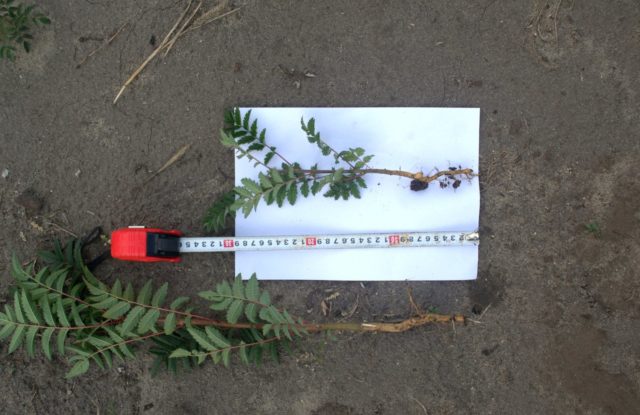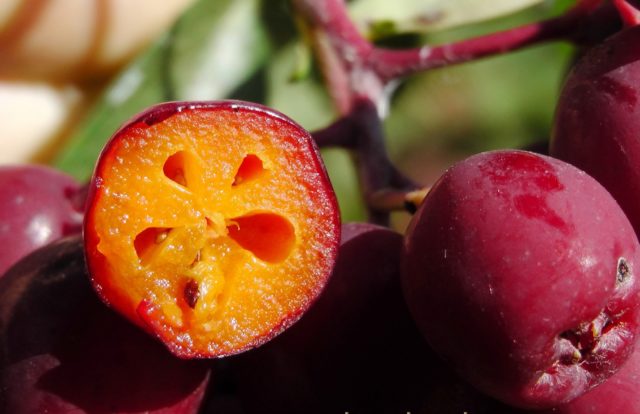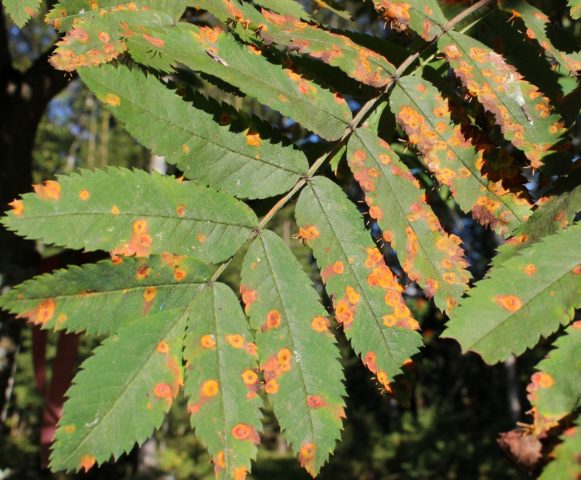Content
Since ancient times, rowan has been highly valued among different peoples: Celts, Scandinavians, Slavs. It was believed that a tree planted near a house would definitely bring happiness, good luck and protect from fire. Rowan branches and leaves are still used as an antiseptic. They prevent deterioration of the vegetables in the basement and purify the water to make it drinkable. The fruits are widely used in folk medicine, both fresh and in the form of decoctions and tinctures. Among the huge number of varieties, Burka's mountain ash stands out. The unusual color of its berries will not leave indifferent gardeners.
Description of Rowan Burka
Rowan Burka represents undersized trees up to 2.5 m high. This variety belongs to interspecific hybrids. Obtained from crossing Alpine and forest mountain ash. It is characterized by an unusual shade of berries - brown-purple. Their taste is predominantly sour with tangible tart notes.
The crown is compact, in the shape of a ball, with beautiful pinnately dissected rich green leaves. The flowers are five-membered, fragrant. According to the descriptions from the photo, Burka's mountain ash blooms from May to June, and begins to bear fruit in late August or September.
Pros and cons of the variety
The advantages of the Burka variety of mountain ash include:
- High yield, from 40 to 50 kg of fruits from one tree.
- Self-pollinating ability, flowers are bisexual.
- High index of frost resistance (zone 4: covers the range from - 39 ° C to - 24 ° C).
- Rowan berries of the Burka variety are rich in vitamins E, P, C, B2, minerals (magnesium, iron, manganese, phosphorus, iodine). They are also high in folic acid and essential oils. Regular consumption of the fruit has a beneficial effect on the entire body.
- The seedlings have good immunity.
There are practically no disadvantages of this variety. The only thing that can confuse gardeners is the slow growth of trees.
Planting and caring for Burka's mountain ash
Rowan varieties Burka thrive best in dry, drained soil. Although she loves moisture, swampy soil is contraindicated for her.
Landing site preparation
According to the description of the variety, Burka's mountain ash belongs to the most unpretentious trees. It takes root on almost any soil, but especially loves sandy loam and loam. The main condition is loose and light soil, which allows oxygen, moisture and nutrients to pass to the roots.
It is best to find a sunny location. The optimal distance from rowan to other trees is 4 to 5 m. The planting pit is prepared in advance, about 3 weeks in advance. Its depth does not exceed 40-50 cm, and its width depends on the volume of the root system of the seedling. Next, you need to prepare the soil. Fertile soil is combined with compost or humus (1 bucket), superphosphate (150 g) and wood ash (300 g). All components must be thoroughly mixed. Now this soil mixture is poured into the pit. It should cover 1/3 of its volume. The remaining space is half filled with any other soil, fertility does not matter.
Landing rules
For planting, you need to take seedlings in which the root reaches about 20 cm.The bark of the plant should be smooth and elastic.
Step-by-step process of planting mountain ash Burka:
- A bucket of water is poured into the prepared pit with the present soil. The moisture should be completely absorbed.
- After that, a seedling is carefully placed in the pit.
- The roots need to be straightened. The root collar does not fully deepen during planting. It should protrude 5-7 cm above the ground.
- Next, the seedling is covered with earth so that all the voids are evenly filled.
- Now you need to level the soil around the trunk. Trampling it down with your feet is not recommended. The ground will become solid and the roots will not develop well. The tree is thoroughly watered.
- It is better to mulch the trunk circles right away. To do this, take humus or peat.
The optimal dates for planting rowan burki are autumn or spring. In the first case, the tree is planted about a month before the first cold weather, in the second - at the beginning of March, in completely thawed soil, until active sap flow begins.
Watering and feeding
Rowan is watered immediately after planting in a permanent place. The next soil moistening is carried out with the beginning of the growing season. Additionally, the tree is watered during a long drought. Also, watering is carried out about 10-15 days before and after harvesting the fruits. The norm for one tree is no more than 3 buckets of water. It is impossible to pour water directly under the root; it is better to water the Burka variety of mountain ash around the trunk circle.
The first top dressing is applied only three years after planting. It occurs in early spring. For one tree, you need to mix humus 5-7 kg with ammonium nitrate 50 g. The next time the fertilizer is applied at the beginning of June. It is best to use organic matter: a solution of mullein or bird droppings (10 liters per tree). Extreme feeding is done in early autumn. Superphosphate (1/2 cup) is mixed with wood ash (2 tablespoons).
Rowan pruning Burka
Pruning begins at the age of two. Depending on the needs, it performs three important functions: it gives the crown a beautiful, neat shape, rejuvenates the tree and regulates its growth. The procedure is started while the kidneys have not swollen yet. Too frequent and strong pruning is detrimental to mountain ash. The bark begins to bare, and the shoots grow too intensively, from which the harvest suffers.
Preparing for winter
During pruning, be sure to get rid of thin shoots. Of them, full-fledged branches will form very soon, which will only randomly thicken the crown.
As for the shelter, the Burka variety of mountain ash calmly tolerates rather severe frosts.
Pollination
Rowan Burka belongs to self-pollinating varieties. To ensure cross-pollination, several different varieties are planted in the garden at once. If the tree for some reason is not pollinated, the mountain ash is grafted with cuttings of other trees.
Harvesting
The rate of fruit ripening depends on the specific region. The first collection of fruits can be started when they acquire the desired color, the pulp becomes dense enough and moderately tough. Usually, the berries become like this by mid-August and by September.
Further, the fruits acquire a sweet taste. Rowan varieties Burka bear fruit until winter.
Diseases and pests
The main enemies of the Burka variety are birds. If you do not follow the tree, they can peck all the berries. Strong trees are resistant to disease and pests. Weakened specimens will become easy prey for apple aphids, weevils, mountain ash moths, and scale insects. You can get rid of them with the help of special drugs.
It is more difficult to deal with necrosis and certain types of mosaics. Proper planting, insect control and good tree care will help prevent diseases.
Reproduction
For the species mountain ash, the most preferable method is seed.
It consists of the following stages:
- Seeds are removed from the ripened berries and washed from the remnants of the pulp, and then allowed to dry.
- Before planting, they are mixed with coarse sand in a ratio of 1: 3.They are in the room for about 8 weeks, after which they are transferred to the refrigerator for several months.
- As soon as the snow melts, the seeds are sown in the greenhouse in regular seedling boxes. Until the arrival of autumn, they are simply watered and periodically loosened the soil.
For reproduction of valuable varieties, they resort to vegetative methods - overgrowth, grafting, layering or cuttings.
Conclusion
Rowan Burka is a great choice for any garden. These trees do not require special conditions, they can stand winters well. It is enough just to water, feed and cut them in a timely manner. In return, gardeners will receive medicinal berries that will help get rid of insomnia, headaches and hypertension.
Reviews of Rowan Burka
I was struck by the shade of the berries. I bought a burka rowan seedling for a summer residence and did not regret it. My tree took root immediately, no special care was required. It bears fruit perfectly. The berries are tart, but after processing they become very tasty. I make jam from them and treat all the neighbors.












